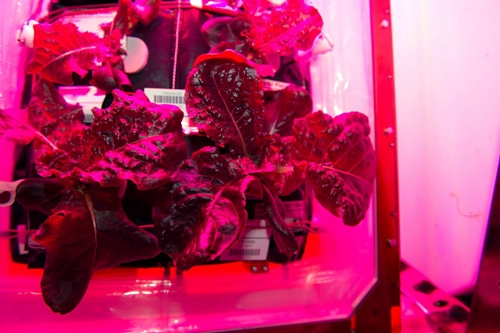10 August 2015. Astronauts in Expedition 44 on the International Space Station plan to eat fresh leafy vegetables today grown in their own lab. The red romaine lettuce on their menus is grown in a plant system, nicknamed Veggie — officially known as Veg-01 — and marks the first crops both grown and consumed in space.
Growing food crops in microgravity is nothing new, but in previous experiments the crops were returned to Earth for analysis. The Veggie technology, if successful, will provide a sustainable source for food production for space flights of long durations, where storing food for the entire mission is impractical.
The space-grown leafy vegetables are the culmination of R&D by NASA and partners going back to 2010. Since that time, researchers experimented with hydroponic plants, grown entirely in water instead of soil and stacked in shelves, and later advanced into aeroponic crop production, where plants were suspended in air, do not need soil, and grow faster than comparable plants in soil.
The Veggie system contains collections of seeds in pods known as pillows to develop their roots, in this case containing romaine seeds with a set of zinnias, delivered to the space station in April 2014. The modular system that includes a panel of multi-colored LEDs to encourage plant growth was designed and built by NASA and Orbital Technologies Corp. in Madison, Wisconsin. The multi-color LEDs give off red and blue light that encourages plant growth, but also green tones to help the romaine lettuce look more appetizing to humans.
Since the space station crew has much more to do than grow vegetables, the project also employed sensors attached to the plants that tell crew members when the crops need watering. The sensors measure leaf thickness that indicates water content, and are monitored by one of the space station’s computers. When the sensors find the plants need water, the system sends text messages to the crew.
Another problem was the build up of ethylene, a natural gaseous hormone given off by plants as they grow. Ethylene accelerates the ripening process, but if it accumulates can also cause the growing crops to spoil. Greenhouses on earth can vent the gas, but not those in space. Air scrubbers, first developed for NASA by KES Science and Technology in Georgia, remove not only ethylene, but also other gaseous compounds, bacteria, mold, viruses, and odors.
An earlier crew grew a test crop of Veggie plants in 33 days, which were returned to earth for safety analysis. The current crew activated the new seed pillows on 8 July and also grew the romaine lettuce plants for 33 days. The following brief (15 second) video shows crew members enjoying their harvest.
- Commercial Space Launch Site Slated for New Zealand
- Space Object Taxonomy Sought in $50K Challenge
- NASA Challenge Seeks Elements for Human Presence on Mars
- XPrize Awards $5.25M for Lunar Technologies
- SpaceX Mission to Carry University Pathogen Research
* * *


 RSS - Posts
RSS - Posts
You must be logged in to post a comment.